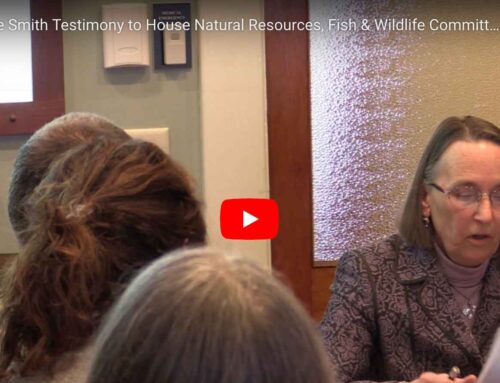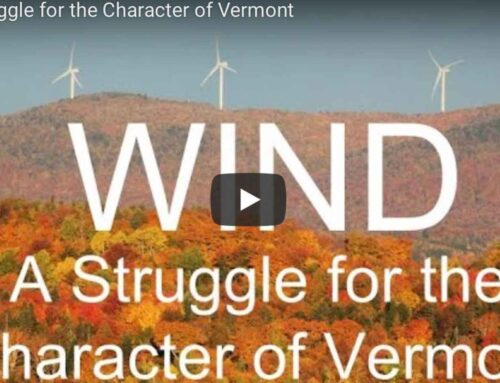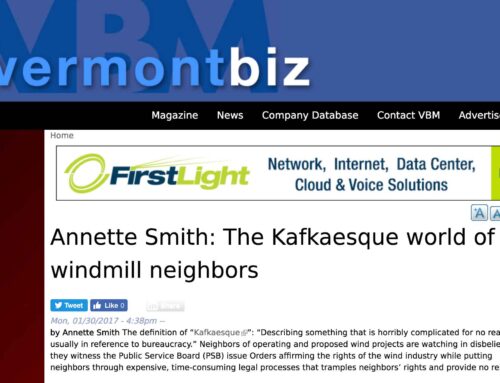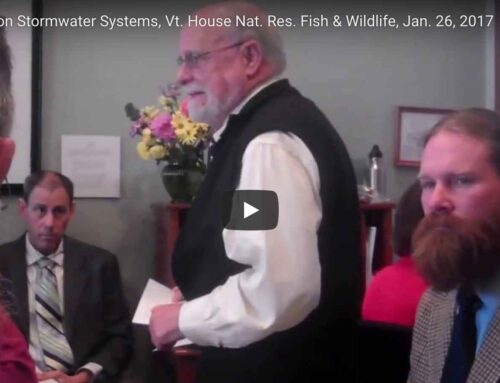On Friday, Feb. 11, at a hastily-called press conference, Governor Shumlin and Agency of Natural Resources (ANR) Secretary Deb Markowitz announced that ANR is signing a deal to “mitigate” impacts to bear habitat on the Lowell Mountains
where Green Mountain Power is proposing to construct 21 huge 3 MW wind turbines. The announcement was coupled with news that Governor Shumlin is endorsing the Lowell Wind project. What really happened? And why?
Update 6/30/11: Public Records show that GMP wrote the talking points for the Governor, and that the Governor’s office and ANR withheld correspondence between ANR’s General Counsel and GMP’s Robert Dostis.
VCE staff met on Wednesday with several ANR staff who were appointed by Gov. Shumlin, including commissioners and attorneys. We were pleased to report after our meetings that ANR staff said they are allowing staff to do their jobs. “Scientists are not being interfered with, the Agency is being run without political interference,” was the message we received. This was welcome news, especially after seeing politics intrude into ANR’s work for the entire 11 years of VCE’s existence, during which we have seen seven Secretaries come and go. So finally the world of environmental protection, at least in Vermont, was going to be determined by good science rather than politics. We were thrilled!
That was Wednesday. One of the main things we discussed was mitigation. Those of us who pay attention to wildlife know that wildlife mitigation does not work. The animals who use the land continue to return, even if it is no longer friendly to them. The agreements ANR staff have entered into regarding bird, bat and bear mitigation for previous wind projects seem to go against what the scientists say in their direct testimony where they identify major impacts, but then say those impacts can be mitigated. Governor Shumlin’s agreement especially runs contrary to good conservation practices because it proposes to mitigate the impacts of destroying wildlife habitat by setting aside wildlife habitat that is already performing important functions and is likely to remain undeveloped anyway. It’s not like somebody puts up signs for the “mitigated” wildlife pointing them where they should move. Somebody already lives there.
I wanted to know why ANR’s scientists were detailing major environmental impacts from building wind turbines on top of mountains, but then saying they could be mitigated. “If the impacts are so bad, why don’t they just say no?” I asked. The response was that they are concerned that if they don’t offer mitigation, the PSB will approve the project without any mechanisms in place to minimize the impacts. That makes sense, but if the scientists honestly believe the impacts should not be mitigated, they should say that first, and only then offer mitigation in case the project is approved over their objections. In any case, we were heartened that the scientists were being allowed to testify without interference.
What a difference a day makes! Friday’s mail contained a letter from Gov. Shumlin saying there is not going to be a wind siting panel and it’s all up to ANR Sec. Markowitz to decide where Vermonters should accept wind projects, and only the host town should have a say,
not surrounding towns like Craftsbury where the town green is centered on the Lowell Mountains.
Then comes the news that Ron Shems, attorney for First Wind in the Sheffield Construction Stormwater Permit appeal, is being appointed by Governor Shumlin to head the Natural Resources Board (which includes the Water Resources Panel) and then, going against everything we had been told by ANR staff on Wednesday, comes the announcement of Governor Shumlin’s deal between ANR and GMP.
VCE has been fielding comments from Vermonters ever since this news was released. Some examples:
- This is an outrage. Chicago style politics are spreading across the country or have we become Soprano territory? Are there any straight politicians?
- This is a very dangerous turn of events. Impacts to the environment, notwithstanding, Shumlin is headed toward some of the most heavy-handed governmental actions that we’ve seen.
- I am so angry – I don’t think I have ever been this angry.
- Disgusted, frustrated and sad.
- The Rape of Vermont is now fully underway.
So what happened? What we’ve heard is that on Friday, facing a trip to Canada to begin negotiating with Hydro-Quebec, Governor Shumlin told ANR leadership to cut a deal so he could take the promise of renewable energy development in Vermont, as exemplified by the Lowell project, to strengthen his position in negotiations. ANR staff scientists were told “sign here,” a deal is being cut, it’s coming from the governor’s office.
VCE is going public with this information because we are fed up with political influence in the Vermont Agency of Natural Resources. Because of this deal, it is quite likely that ANR community ecologist Eric Sorensen’s testimony will be squelched, along with the testimony of all the other ANR staff scientists who have devoted countless hours to understanding and articulating the environmental impacts of wind turbine construction on the Lowell Mountains.
Political interference in ANR’s role in wind projects is nothing new. Despite his supposed opposition to wind development on ridgelines, Governor Douglas’ ANR did the same thing with First Wind’s Sheffield project. ANR staff filed testimony but did not appear to testify before the Public Service Board because ANR entered into an MOU with First Wind (p. 85). Gov. Douglas struck a better dealing, getting more than 2700 acres set aside while Gov. Shumlin’s deal is for 290 acres. Under Douglas’ leadership, ANR also fiercely litigated against the neighbor group led by an expert on aquatics and defended its stormwater construction permit (on the same side as First Wind, represented by Ron Shems) issued for Sheffield.
Sheffield Wind Turbine Construction by First Wind
In the Lowell case, the PSB is in the middle of hearings. John Austin and John Buck of ANR testified last Monday. Shannon Morrison, Kevin Burke, and Eric Sorenson are scheduled to testify when hearings continue week after next. Governor Shumlin has now intruded into the Public Service Board’s ongoing quasi-judicial hearing proceedings in a way that destroys whatever confidence Vermonters might have had that wind development proposals will get a fair hearing.
One Vermonter wrote to VCE,
“Why not save money, disband the ANR and let Shumlin make all the decisions on our environment?”
Vermonters, and particularly the people who live around the Lowell mountains who are following the PSB proceedings in detail are enormously frustrated and angry about the Governor’s interference in regulatory proceedings. Even worse, Governor Shumlin made a deal about bears, but seems willing to ignore the human species who are facing serious threats to their health and investments. No mechanisms exist to address problems neighbors are likely to face after the wind turbines are erected. The PSB is not accustomed to playing the role of enforcer. Neighbors of the Vinalhaven, Maine wind project that has been creating noise problems for neighbors for more than a year just issued these recommendations:
If you live where a wind company is trying to ruin your life, but which has not yet succeeded, it’s time to plan for what you’re going to do if they do manage to force their way in.
- take measurements for pre-construction noise now.
- start fund-raising now.
- contact your State Dept of Environmental Protection (DEP) to find out what measurements you may have to take to protect your property from the wind company breaking the law.
- ensure the burden of proof will be on the wind company (and not you) to show they are “not out of compliance”—ever! This is vastly different than showing they are “in compliance.”
- I warn you, your State DEP doesn’t have the money to afford to monitor the installation to protect you and all other sites.
- if the burden is not on the wind company to prove they are never out of compliance, you won’t be able to protect yourself from extreme noise levels, the high cost of measurement, sound consulting and legal fees, meetings with the DEP, etc.
Vermonters are also frustrated by the lack of understanding of energy issues Vermont’s leadership is exhibiting. Department of Public Service energy planner, Dave Lamont, initially testified in the Lowell PSB case that GMP’s proposal is not in the public good. Then he flipped his position and testified in writing that it is in the public good.
Wednesday morning, Feb. 9, DPS’ energy planner Dave Lamont told the Vermont Senate Natural Resources and Energy committee:
“We’re also in a situation where because of future natural gas prices and the projections of future natural gas prices, power prices are likely to be quite low for the next 10 or a dozen years, the forecasts are for really historically low prices so it’s not going to be difficult to fill in that gap….what we’ve learned is you can’t beat the market.”
So on the one hand Dave Lamont is testifying to the PSB that the GMP Lowell project is now in the public good even though the DPS aesthetics expert says the impact will be unduly adverse. But then Mr. Lamont tells the Senate committee that for the next 10 years, the market is going to be the cheapest source of power. Meanwhile, Governor Shumlin is apparently trying to use the Lowell project to negotiate low-priced long-term contracts with Hydro-Quebec, even though the evidence is that GMP’s Lowell wind power is going to be very expensive power compared to the recently-negotiated contract with H-Q or market power.
Wind energy development is one ugly business. It seems to bring out the worst in people. It divides communities, pits neighbor against neighbor, provides opportunities for corruption because of all the money involved, much of which is coming from the federal government, adding to our deficit. We are operating on the assumption that we have to have in-state renewables and we have to have wind to meet that need. We need to stop and first discuss what energy we need, where to get it, and what makes sense for Vermont. Maybe wind is the wrong choice, maybe that assumption is wrong.
VCE has been politely asking our legislators to have the conversation that we must have about whether this technology is right for Vermont, and if so, how we can develop it in a way that respects our communities rather than destroys them. If it is wrong for Vermont, can we please move on to technologies like solar that are more appropriate for this state and provide meaningful energy solutions? So far, wind energy has shown itself to be an incredible sink of time, energy and money, a poor use of resources. We were able to tell this to the Connecticut legislative Committee on Energy and Technology two weeks ago.
When will Vermonters get the opportunity to have a rational discussion about renewable energy? What kind of process do we need to move renewable energy development forward, and what technologies will work in Vermont?













I attended the News Conference organized by Lucas Snelling and VCE on 2/24 in Montpelier, well done and my thanks. Gov. Shumlin did not, choosing instead to visit (for the first time) the town of Lowell and meet there with proponents and opponents, according to the B/Free Press today. This visit came, suddenly, after his repeated refusals to come to the NEK to meet with us while the PSB hearings were going on. The extraordinary manipulation of the PSB process by the executive branch is outrageous and reeks of political payback to GMP by Shumlin. It seems that liberal Shumlin tolerates advocacy as long as it’s not successful. The effective ground work being done by so many differant groups and individuals in opposition to this industrial project can be the only explanation of why Shumlin felt the need to throw his office and, by association, the ANR behind GMP. Pathetic.
[…] Fish & Wildlife Service staff concerns about impacts to water resources. Governor Shumlin helped Green Mountain Power overcome ANR staff concerns about natural resource impacts in Lowell. The Public Service Board ignored recommendations by […]
Here is an article about Lowell Wind energy
http://theenergycollective.com/willem-post/61309/lowell-mountain-wind-turbine-facility-vermont